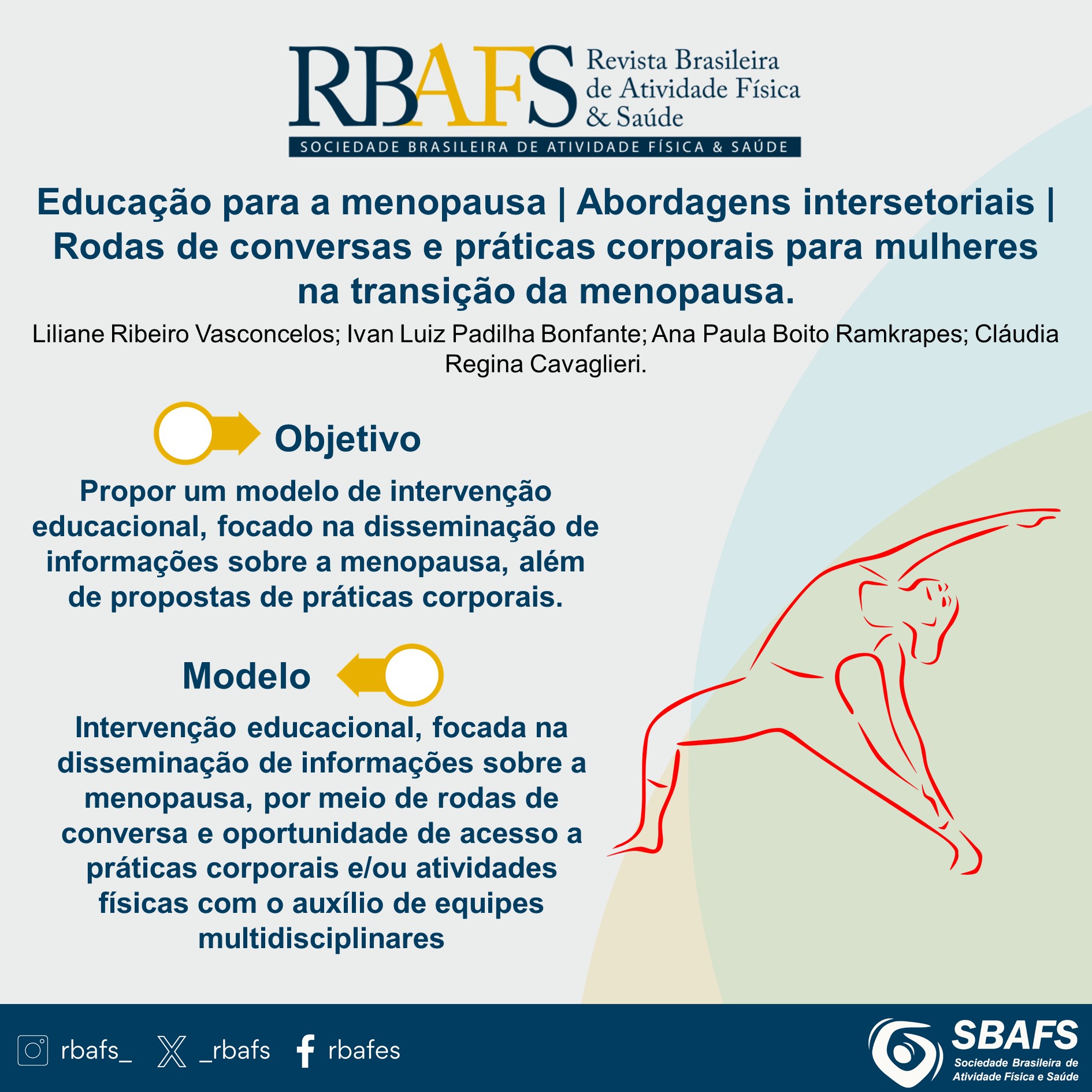Menopause Education: Intersectorial approaches, conversational circles and body practices for women in menopausal transition
DOI:
https://doi.org/10.12820/rbafs.29e0369Keywords:
Menopause, Health communication, Body practicesAbstract
Introduction: Menopause is a natural event in a woman’s life that marks the end of the reproductive period. It is characterized by physical and psychological symptoms caused by the cessation of ovarian hormone production, which can lead to health and quality of life issues. Physical activity has been an important tool in Primary Health Care to minimize the effects of this period. However, several barriers, such as social and emotional factors, lack of infrastructure, and safety concerns, limit these women’s access to an active lifestyle. Additionally, there is still a lack of information and knowledge about this stage of life and how physical activities can beneficially influence it. Objective: To propose an educational intervention model focused on disseminating information about menopause through discussion groups and providing access to physical activities and body practices. Final considerations: Multidisciplinary teams should facilitate access to information and specialized support, encouraging women to adopt self-care habits, including physical activities and leisure, aiming to improve their quality of life and health.
Downloads
References
Davis SR, Lambrinoudaki I, Lumsden M, Mishra GD, Pal L, Rees M, et al. Menopause. Nat Rev Dis Primers. 2015;23(1):1-19. DOI: https://doi.org/10.1038/nrdp.2015.4
Harlow SD, Gass M, Hall JE, Lobo R, Maki P, Rebar RW, et al. Executive summary of the stages of reproductive aging workshop + 10: Addressing the unfinished agenda of staging reproductive aging. J Clin Endocrinol Metab. 2012;97(4):1159–68. DOI: https://doi.org/10.1210/jc.2011-3362
Lobo RA. Chapter 14. Menopause and Aging. In: Jerome F. Strauss, Robert L. Barbieri, Yen and Jaffe's. J Reprod Endocrinol (Eighth Edition). Elsevier, 2019. p. 322-56. DOI: https://doi.org/10.1016/B978-0-323-47912-7.00014-7
Guyton AC 1919, Hall JE 1946 (John E, Geo Consultoria Editorial. Tratado de fisiologia médica. Elsevier; 2017.
Mauvais-Jarvis F, Clegg DJ, Hevener AL. The role of estrogens in control of energy balance and glucose homeostasis. Endocr Rev. 2013;34(3): 309–38. DOI: https://doi.org/10.1210/er.2012-1055
Gold EB, Colvin A, Avis N, Bromberger J, Greendale GA, Powell L, et al. Longitudinal analysis of the association between vasomotor symptoms and race/ethnicity across the menopausal transition: Study of women’s health across the nation. Am J Public Health. 2006;96(7):1226–35. DOI: https://doi.org/10.2105/AJPH.2005.066936
Mishra GD, Kuh D. Health symptoms during midlife in relation to menopausal transition: British prospective cohort study. BMJ. 2012;344:e402. DOI: https://doi.org/10.1136/bmj.e402
Faubion SS, Kingsberg SA, Clark AL, Kaunitz AM, Spadt SK, Larkin LC, et al. The 2020 genitourinary syndrome of menopause position statement of the North American Menopause Society. Menopause. 2020;27(9):976–92. DOI: https://doi.org/10.1097/GME.0000000000001609
Karvonen-Gutierrez C, Kim C. Association of mid-life changes in body size, body composition and obesity status with the menopausal transition. Healthcare. 2016;4(3):42. DOI: https://doi.org/10.3390/healthcare4030042
IBGE. Censo total homens e mulheres e por grupos de idade de 1940 a 2022. Disponível em: <https://agenciadenoticias.ibge.gov.br/media/com_mediaibge/arquivos/6e3da28dfe74401c5464880d8896197f.pdf> [2023 Junho].
Peate M, Johnson TL, Avis NE, Hickey M. Addressing sociodemographic, socioeconomic, and gendered disparities for equity in menopause care. Cell Rep Med. 2024;5(6):101616. DOI: https://doi.org/10.1016/j.xcrm.2024.101616
Brasil. Ministério da Saúde. Boletim Epidemiológico. Saúde da mulher brasileira: uma perspectiva integrada entre vigilância e atenção à saúde. Disponível em: [2023 Março].
Arocha Rodulfo JI. Sedentarism, a disease from xxi century. Clin Investig Arterioscler. 2019;31(5):233–40. DOI: https://doi.org/10.1016/j.artere.2019.04.001
Gomes GAO, Papini CB, Nakamura PM, Teixeira IP, Kokubun, E. Barriers for physical activity in Primary Health Care. Rev Bras Cienc Esporte. 2019;41(3):263–270. DOI: https://doi.org/10.1016/j.rbce.2018.04.007
Brasil. Ministério da Saúde. Secretaria de Vigilância em Saúde. Secretaria de Atenção à Saúde. Política Nacional de Promoção da Saúde / Ministério da Saúde, Secretaria de Vigilância em Saúde, Secretaria de Atenção à Saúde. 2010 – 3. ed. – Brasília: Ministério da Saúde, 2010.
Lazzarotti Filho A, Silva AM, Antunes PC, Silva APS, Leite JO. O termo práticas corporais na literatura científica brasileira e sua repercussão no campo da educação física. Movimento. 2010;16(1):11-29. DOI: https://doi.org/10.22456/1982-8918.9000
World Health Organization. Physical Activity Fact Sheet. Disponível em:
<https://www.who.int/news-room/fact-sheets/detail/physical-activity> [2024
Setembro].
Brasil. Ministério da Saúde. Diretrizes para reorganização das equipes multiprofissionais na atenção primária à saúde. Brasília: Ministério da Saúde; [2024 setembro]. Disponível em: <https://sei.saude.gov.br/sei/controlador.php?acao=documento_imprimir_web&id_documento=37670100> [2022 Janeiro]
Ministério da Saúde. Aproximações ao tema: Promoção da Saúde. Caderno 1. 2021. Brasília: Ministério da Saúde, 2021. Disponível em: <http://bvsms.saude.gov.br/bvs/publicacoes/promocao_saude_aproximacoes_tema.pdf> [2022 Janeiro] DOI: https://doi.org/10.12820/rbafs.27e0248
Mandrá PP, Silveira FDF. Satisfação de usuários com um programa de Roda de Conversa em sala de espera. Audiol Commun Res. 2013;18(3):186-93. DOI: https://doi.org/10.1590/S2317-64312013000300008
Hickey M, Basu P, Sassarini J, Stegmann ME, Weiderpass E, Nakawala Chilowa K, et al. Managing menopause after cancer. The Lancet. 2024;403(10430):984–96. DOI: https://doi.org/10.1016/S0140-6736(23)02802-7
Stute P, Ceausu I, Depypere H, Lambrinoudaki I, Mueck A, Pérez-López FR, et al. A model of care for healthy menopause and ageing: EMAS position statement. Maturitas. 2016;92:1–6. DOI: https://doi.org/10.1016/j.maturitas.2016.06.018
Lee C, Dobson AJ, Brown WJ, Bryson L, Byles J, Warner-Smith P, et al. Cohort Profile: The Australian longitudinal study on Women’s Health. Int J Epidemiol. 2005;34(5):987–91. DOI: https://doi.org/10.1093/ije/dyi098
Committee E. Menopause and the workplace: Government Response to the Committee’s First Report of Session 2022-2023/Fourth Special Report of Session 2022-23. Disponível em:<https://committees.parliament.uk/work/1416/menopause-and-the-workplace/> [2023 Janeiro].

Downloads
Published
How to Cite
Issue
Section
License
Copyright (c) 2024 Liliane Vasconcelos

This work is licensed under a Creative Commons Attribution 4.0 International License.
When submitting a manuscript to the Revista Brasileira de Atividade Física & Saúde, the authors retain the copyright to the article and authorize the Revista Brasileira de Atividade Física & Saúde to publish the manuscript under the Creative Commons Attribution 4.0 License and identify it as the original publication source.


